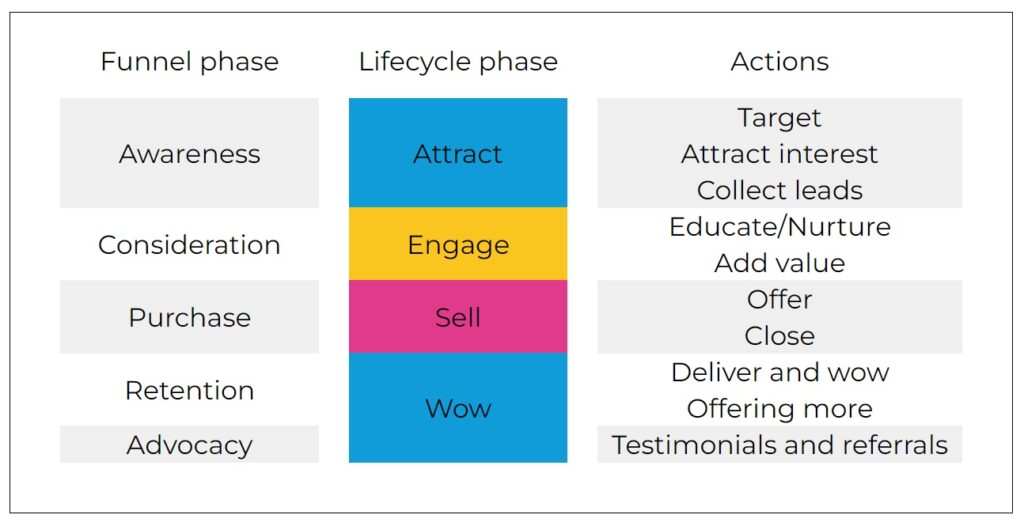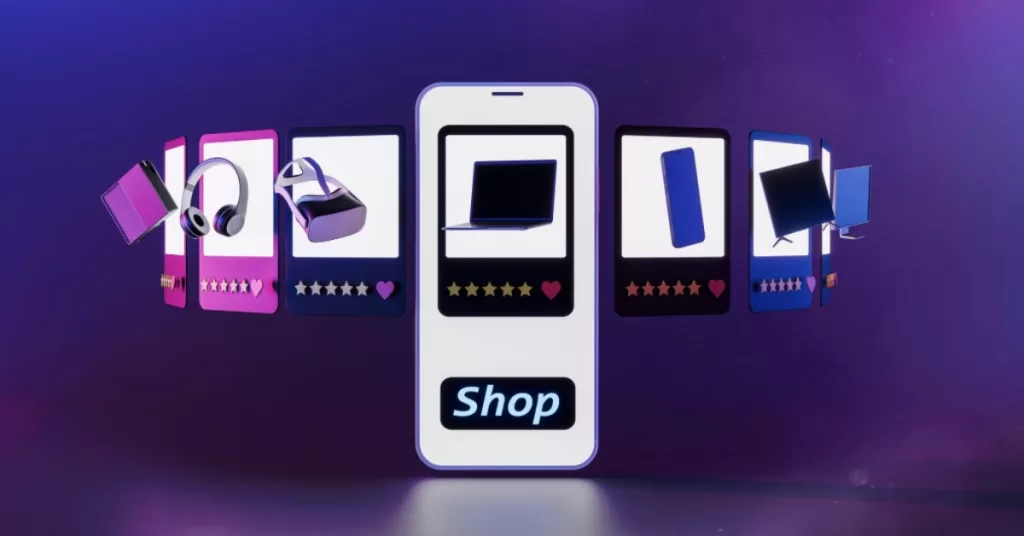Lifecycle marketing is a marketing approach that focuses on building a relationship with your customers throughout their entire purchasing journey. It is a cyclical process that involves attracting potential customers, engaging with them, selling them the product or service you are offering, and making them reach the ‘wow moment’ so they become loyal customers.
This framework was developed to help companies guide their customers through specific steps that would lead to selling their products and keeping their customers for longer.
The lifecycle marketing framework
There are four phases in the lifecycle marketing framework: attract, engage, sell, and wow. And for each of these, you will need to find the best mix of channels and messaging to target your users with.

Attract
In this phase, you’re trying to identify your ideal customer and understand their needs and wants. Because this will help you tremendously to target them effectively and start catering your marketing towards them.
Once you do that, you will need to attract their interest. This is a little tricky at first because of the sheer number of companies competing for their attention. But if you did your research right and know their pain points, you can capitalize on that.
Keep in mind that the goal of this first step is not to get them on your website. Website visits are good, but they don’t offer you any extra information about the person behind the click. You want to know who they are, so collecting their name and contact information (email address, phone, number, etc.) is the key to moving them further down the funnel.
You can do all this by:
- Utilizing SEO and PPC to reach new audiences and give them the information they are looking for.
- Creating valuable content that they want to read or listen to. The most valuable content is the one that they are willing to exchange their contact information for.
- Building brand awareness through social media engagement – reply to comments and questions on social media.
- Running giveaways and contests to generate excitement about your brand.
- Sending personalized newsletters to your subscribers.
Engage
Once you’ve attracted potential customers, you need to start building relationships with them by educating and nurturing them.
This is the point where you’re telling them ‘Ok, you’ve got a problem and this is the point you’re at. Let’s help you understand what that is and how you can fix it.’
You can do this by providing valuable content, such as more product-oriented blog posts, ebooks, or webinars. You can also interact with potential customers on social media or through email marketing.
So you’re really building that relationship by adding value. And this is really important. You don’t want to tell them how great your product is because they don’t care and you will only lose their attention. What you really want to do is to make their life better in an incremental way.
You can do this by:
- Providing in-depth product information and comparisons while focusing on their pain points.
- Building trust, establishing credibility, and creating long-lasting relationships with email nurturing campaigns.
- Offering free trials or demos to further build trust and provide them with even more information about how your product fits their needs and fixes their problems.
- Training your sales team to be consultative and focus more on building a relationship with customers.
Sell
Once you’ve nurtured a relationship with a potential customer, you can start thinking about selling them your products or services. However, it’s important to make sure that your offers are relevant to the customer’s needs and that you’re not being too pushy.
The whole idea here is saying something along the lines of: ‘Ok, I know that you’ve got a problem, I’ve given you some information on how you can solve it, and this is where my product can help you’
But once, you’ve offered your product and laid everything on the table, you don’t want to just run off. You still need to close the deal. So you might want to pick up the phone and talk with them to see what objections they might have. Or follow up with a separate email sequence to make that happen.
You can do this by:
- Streamlining the buying process for a smooth experience. You want to address most, if not all, of their objections before offering them the product or service.
- Providing exceptional customer service for those free trials. This will give them the trust and confidence that your service is top-notch and that you will be there for them in the future, as well.
- Making it about them: don’t push your product towards them, but try to start a conversation about their unique situation. See if or how exactly you can make their work or life easier.
Wow
After you’ve made a sale, it’s important to continue to keep your customers happy. This can be done by providing excellent customer service, offering exclusive discounts or promotions, or going the extra mile to exceed their expectations. By wowing your customers, you’ll encourage them to come back for more and to recommend your business to others.
Only after you have accomplished this, you can then think about offering more. Once you’ve already knocked their socks off and they’re happy, you can think about upselling and cross-selling.
You can do this by:
- Offering excellent customer service by being responsive, helpful, and friendly.
- Offering exclusive discounts or promotions to your loyal customers.
- Going the extra mile to help your customers succeed by providing them with free training.
- Sending birthday greetings or any type of personalized message to your customers.
- Asking your customers for feedback and use it to improve your products and services. Even a small contribution will spark a huge sense of pride and will make them stick with you for longer.
- Running re-engagement campaigns to win back inactive customers.
- Upselling and cross-selling relevant products.
The befits of lifecycle marketing
When done right, lifecycle marketing can have huge benefits for your business. It helps you build your brand, your reputation, and grow your business faster.
By focusing on the clients and their needs you are making sure that your product is a good fit for them, and reducing the likelihood of them experiencing buyer’s remorse.
Some of the benefits of lifecycle marketing are:
- Increased customer lifetime value (CLTV): satisfied customers are more likely to return for future purchases or use your service for longer.
- Reduced customer acquisition costs: acquiring a new customer is often more expensive than retaining existing ones. If you can improve your retention rate you can increase your marketing efficiency ratio and reduce the need for constant customer acquisition.
- Enhanced brand loyalty and advocacy: with personalized experiences, you will build stronger bonds with your customers. They will trust your brand and build an emotional connection which will lead to them choosing to stay with you even if your competitors are targeting them, or they will actively recommend your business to their networks.
Conclusion
Lifecycle marketing is not a silver bullet that will magically solve all your business issues. But it is a powerful way of driving revenue with a customer-centric approach.
You just have to remember that with this approach it’s all about your customer and not you or your business. The client cares much more about the value you will bring to their business or life than how you do things and what tech you provide. And if you properly take care of them, they will stick around and make sure to refer you to their peers.
As one of my clients once said to me:
‘Help me get rich, so I can make you rich!’
Matt
And besides happily paying more for the service as his business grew, he also sent a few clients my way.



